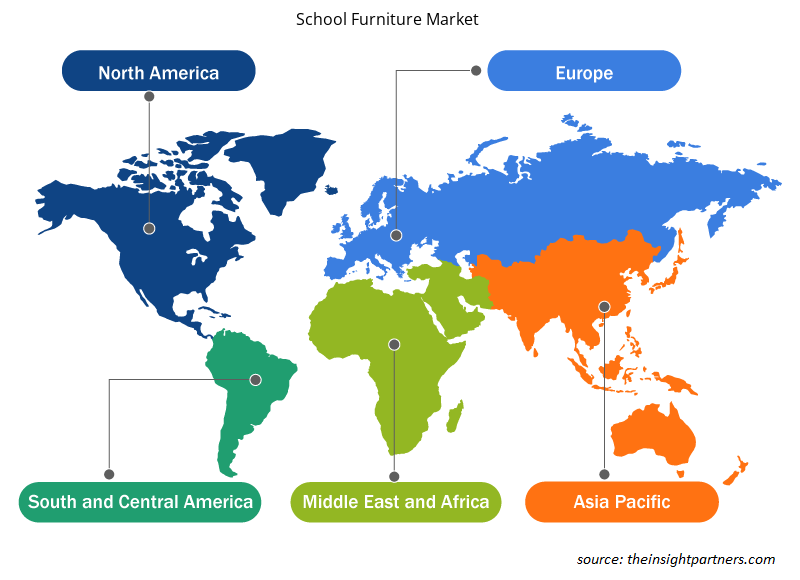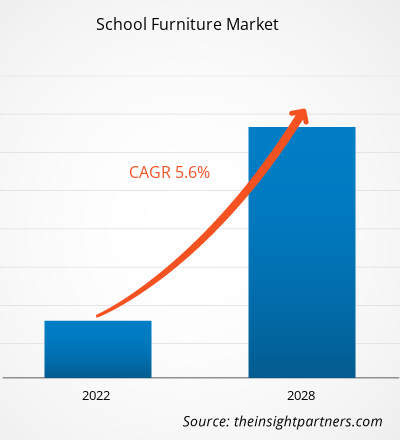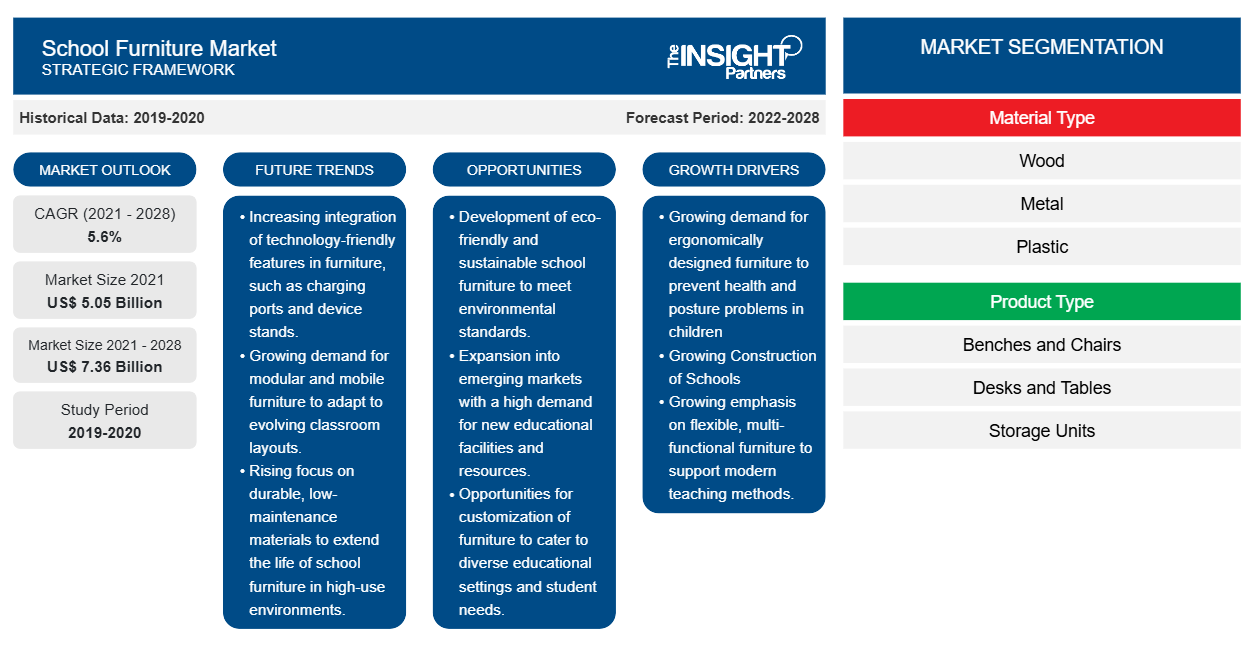[Rapport de recherche] Le marché mondial du mobilier scolaire était évalué à 5 047,95 millions USD en 2021 ; il devrait croître à un TCAC de 5,6 % de 2022 à 2028.
Le mobilier scolaire, qui comprend des étagères, des casiers, des armoires, des tableaux d'affichage, des bureaux, des chaises, des classeurs et des armoires de rangement, ainsi que du matériel de laboratoire, est fabriqué à partir de matériaux robustes, faciles à utiliser et de haute qualité, tels que le bois, les métaux, les panneaux de fibres à densité moyenne (MDF) et les plastiques. Le mobilier scolaire est conçu de manière à assurer le bien-être physique et mental, permettant aux élèves de se concentrer pleinement sur leurs études. Il contribue également à améliorer la flexibilité et la productivité globale des enseignants et des élèves tout en transformant l'espace physique en un environnement d'apprentissage dynamique.
La demande croissante de mobilier ergonomique pour prévenir les problèmes de santé et de posture chez les enfants est le facteur clé qui stimule le marché. Créer des environnements d'apprentissage qui maintiennent les élèves concentrés et à l'aise est devenu l'un des principaux objectifs des éducateurs, influençant ainsi positivement le marché mondial du mobilier scolaire . Avec la nouvelle ère des styles d'enseignement complets, interactifs et dynamiques tels que l'apprentissage mixte et les classes inversées, des meubles portables et réglables avec une reconfiguration facile sont devenus nécessaires.
Personnalisez ce rapport en fonction de vos besoins
Vous bénéficierez d'une personnalisation gratuite de n'importe quel rapport, y compris de certaines parties de ce rapport, d'une analyse au niveau des pays, d'un pack de données Excel, ainsi que de superbes offres et réductions pour les start-ups et les universités.
-
Obtenez les principales tendances clés du marché de ce rapport.Cet échantillon GRATUIT comprendra une analyse de données, allant des tendances du marché aux estimations et prévisions.
De plus, plusieurs matières premières sont introduites pour la production de meubles, et ces matériaux distincts se sont avérés plus durables, plus résistants et plus stables que les matériaux traditionnels, ajoutant ainsi une impulsion à la croissance du marché. Les producteurs utilisent des matériaux tels que le bois transformé ou reconstitué, le plastique moulé et le stratifié haute pression pour fabriquer des bancs, des chaises et des tables pour les salles de classe et les écoles. Les meubles avec des options de rangement supplémentaires agissent comme une tactique d'économie d'espace dans les salles de classe plus petites et compactes, et la demande pour ces mêmes meubles a observé une augmentation significative ces dernières années. Par exemple, CBT Supply Dba Smartdesks produit des tables et des chaises intelligentes avec des options empilables et des applications multifonctionnelles pour les salles de classe et les bureaux. Par conséquent, la demande croissante de meubles flexibles stimulera la croissance du marché au cours de la période de prévision.
Informations sur le marché
Construction croissante d'écoles
La construction d’écoles dans le monde entier devrait augmenter en raison de la croissance rapide de la population. L’attention croissante portée au secteur éducatif dans les zones urbaines et rurales et les programmes d’enseignement primaire obligatoire fournis par les gouvernements du monde entier stimulent la croissance de la construction d’écoles. Selon le Center on Budget and Policy Priorities, en 2018, environ 98,9 milliards de dollars américains ont été dépensés en Amérique du Nord pour des projets d’infrastructures éducatives, ce qui indique une augmentation des dépenses de près de 10 % depuis 2017. Avec l’augmentation des installations scolaires, les classes surpeuplées, les changements dans les codes de sécurité des bâtiments et les avancées technologiques à l’échelle mondiale, les responsables sont confrontés au dilemme d’investir dans de nouvelles infrastructures ou de moderniser celles existantes. Les gouvernements et les sociétés du monde entier s’efforcent de développer leurs systèmes éducatifs et de garantir que tous les élèves ont la possibilité d’aller à l’école et d’acquérir les compétences et les connaissances nécessaires pour mener une vie productive et saine. Pour améliorer la qualité de l’éducation, les infrastructures éducatives doivent être modernisées.
De plus, la croissance du nombre d’étudiants à travers le monde a stimulé la demande de tables et de chaises de classe, car elles sont nécessaires au fonctionnement de l’école. L’adoption croissante de matières premières non conventionnelles pour le mobilier scolaire conduit à des rénovations, des collaborations et des meubles ergonomiques pour les salles de classe. Plusieurs écoles remplacent progressivement le mobilier scolaire traditionnel par des infrastructures esthétiques attrayantes pour rendre l’environnement de la classe agréable. L’introduction de chaises pivotantes dotées de caractéristiques ergonomiques est un ajout récent à de nombreuses écoles.
Informations sur les types de matériaux
En fonction du type de matériau, le marché du mobilier scolaire est segmenté en bois, métal, plastique et autres. En 2021, le segment du bois a dominé le marché du mobilier scolaire.
Fleetwood Furniture; Herman Miller, Inc; KI; Steelcase Inc.; Virco, Inc.; Scholar Craft; Global Furniture Group; Educan; Ven-Rez; et Mitybilt font partie des principaux acteurs opérant sur le marché du mobilier scolaire. Les principaux acteurs adoptent diverses stratégies, telles que les fusions et acquisitions et les lancements de produits, pour étendre leur présence géographique et leur clientèle.
Rapports en vedette
- Tendances progressistes dans le secteur du mobilier scolaire pour aider les acteurs à développer des stratégies efficaces à long terme
- Stratégies de croissance commerciale adoptées par les entreprises pour assurer leur croissance sur les marchés développés et en développement
- Analyse quantitative du marché du mobilier scolaire de 2021 à 2028
- Estimation de la demande de mobilier scolaire dans divers secteurs d'activité
- Analyse PEST pour analyser les changements politiques, économiques, socioculturels et technologiques dans l'environnement des affaires
- Développements récents pour comprendre le scénario concurrentiel du marché et la demande de mobilier scolaire
- Tendances et perspectives du marché associées aux facteurs qui stimulent et freinent la croissance du marché du mobilier scolaire
- Stratégies qui soutiennent l'intérêt commercial à l'égard de la croissance du marché du mobilier scolaire, aidant au processus de prise de décision
- La taille du marché du mobilier scolaire à différents nœuds du marché
- Aperçu détaillé et segmentation du marché du mobilier scolaire, ainsi que de sa dynamique industrielle
Le rapport « Prévisions du marché du mobilier scolaire jusqu'en 2028 » est une étude spécialisée et approfondie de l'industrie des produits chimiques et des matériaux, axée sur l'analyse des tendances du marché du mobilier scolaire. Le rapport vise à fournir un aperçu du marché avec une segmentation détaillée du marché. Le marché du mobilier scolaire est classé en fonction du type de matériau, du type de produit et du canal de distribution. En fonction du type de matériau, le marché est segmenté en bois, métal, plastique et autres. En fonction du type de produit, le marché est divisé en résidentiel et commercial et industriel. En termes de canal de distribution, le marché est divisé en magasins spécialisés, vente au détail en ligne et contrats/offres.
Aperçu régional du marché du mobilier scolaire
Les tendances et facteurs régionaux influençant le marché du mobilier scolaire tout au long de la période de prévision ont été expliqués en détail par les analystes d’Insight Partners. Cette section traite également des segments et de la géographie du marché du mobilier scolaire en Amérique du Nord, en Europe, en Asie-Pacifique, au Moyen-Orient et en Afrique, ainsi qu’en Amérique du Sud et en Amérique centrale.

- Obtenez les données régionales spécifiques au marché du mobilier scolaire
Portée du rapport sur le marché du mobilier scolaire
| Attribut de rapport | Détails |
|---|---|
| Taille du marché en 2021 | 5,05 milliards de dollars américains |
| Taille du marché d'ici 2028 | 7,36 milliards de dollars américains |
| Taux de croissance annuel moyen mondial (2021-2028) | 5,6% |
| Données historiques | 2019-2020 |
| Période de prévision | 2022-2028 |
| Segments couverts |
Par type de matériau
|
| Régions et pays couverts |
Amérique du Nord
|
| Leaders du marché et profils d'entreprises clés |
|
Densité des acteurs du marché du mobilier scolaire : comprendre son impact sur la dynamique commerciale
Le marché du mobilier scolaire connaît une croissance rapide, tirée par la demande croissante des utilisateurs finaux en raison de facteurs tels que l'évolution des préférences des consommateurs, les avancées technologiques et une plus grande sensibilisation aux avantages du produit. À mesure que la demande augmente, les entreprises élargissent leurs offres, innovent pour répondre aux besoins des consommateurs et capitalisent sur les tendances émergentes, ce qui alimente davantage la croissance du marché.
La densité des acteurs du marché fait référence à la répartition des entreprises ou des sociétés opérant sur un marché ou un secteur particulier. Elle indique le nombre de concurrents (acteurs du marché) présents sur un marché donné par rapport à sa taille ou à sa valeur marchande totale.
Les principales entreprises opérant sur le marché du mobilier scolaire sont :
- Meubles Fleetwood
- Herman Miller, Inc.
- KI
- Steelcase Inc.
- Virco, Inc.
Avis de non-responsabilité : les sociétés répertoriées ci-dessus ne sont pas classées dans un ordre particulier.

- Obtenez un aperçu des principaux acteurs du marché du mobilier scolaire
Profils d'entreprise
- Meubles Fleetwood
- Herman Miller, Inc
- KI
- Steelcase Inc.
- Virco, Inc.
- Artisanat d'érudit
- Groupe mondial de meubles
- Éducatif
- Ven-Rez
- Mitybilt
- Analyse historique (2 ans), année de base, prévision (7 ans) avec TCAC
- Analyse PEST et SWOT
- Taille du marché Valeur / Volume - Mondial, Régional, Pays
- Industrie et paysage concurrentiel
- Ensemble de données Excel
Rapports récents
Témoignages
Raison d'acheter
- Prise de décision éclairée
- Compréhension de la dynamique du marché
- Analyse concurrentielle
- Connaissances clients
- Prévisions de marché
- Atténuation des risques
- Planification stratégique
- Justification des investissements
- Identification des marchés émergents
- Amélioration des stratégies marketing
- Amélioration de l'efficacité opérationnelle
- Alignement sur les tendances réglementaires























 Obtenez un échantillon gratuit pour - Marché du mobilier scolaire
Obtenez un échantillon gratuit pour - Marché du mobilier scolaire